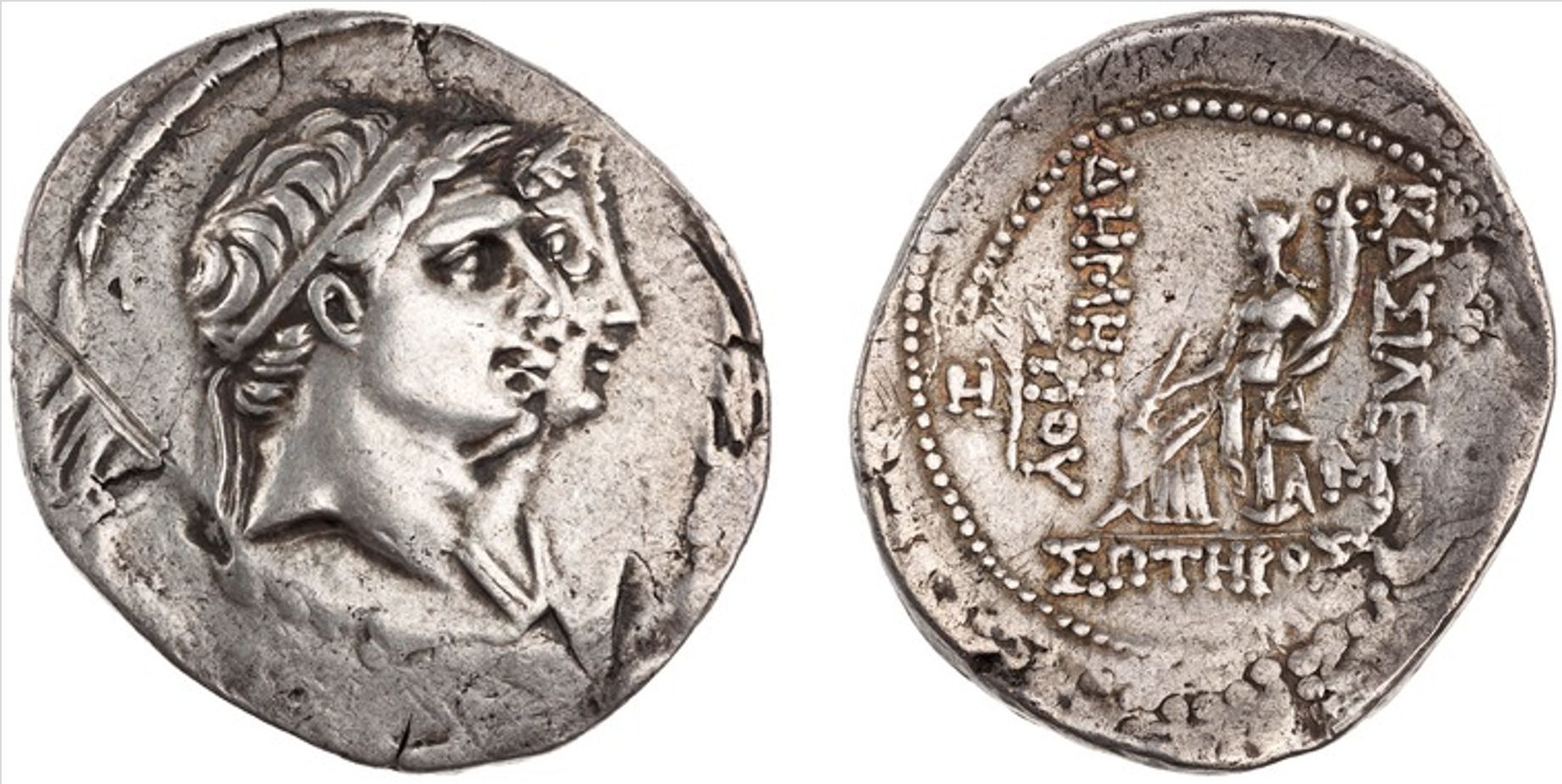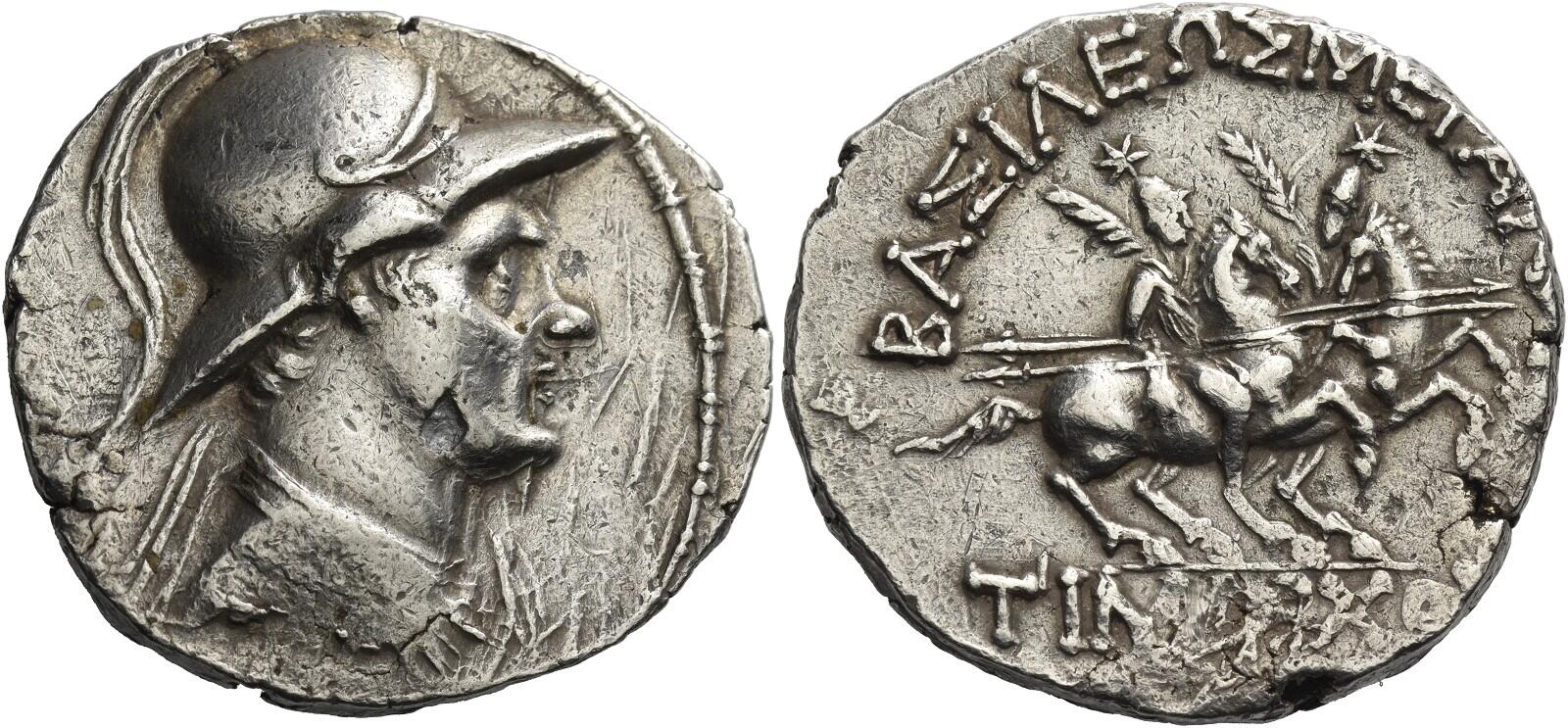161 BCE - 150 BCE | ΒΑΣΙΛΕΩΣ ΔΗΜΗΤΡΙΟΥ ΣΩΤΗΡΟΣ
Overstriking coin
SO 1174 - Seleuceia ad Tigrim over uncertain mint.png
Overstruck variety
Timarchus Dioscuri.jpeg
[1]
| Museum collectionMuseum collection:
|
New York, American Numismatic Society, 1967.130.1
|
|
|
|
|
Description
| ObverseInscription or printing placed on the obverse.:
|
Jugate heads of Demetrios diademed and Ladike draped and wearing stephane right.
|
ReverseInscription or printing placed on the reverse.:
|
ΒΑΣΙΛΕΩΣ ΔΗΜΗΤΡΙΟΥ ΣΩΤΗΡΟΣ (Greek) Tyche seated left, throne supported by winged tritoness, holding scepter and cornucopia. In outside left field, H and palm. Border of dots.
|
Mint and issuing power
Chronology
| FromIdentifies the initial date in a range assigned in a numismatic context. 161 BCE toIdentifies the final date in a range assigned in a numismatic context.. 150 BCE
|
hellenistic periodTime period of the numismatic object.
|
Physical description
MetalThe physical material (usually metal) from which an object is made.: Silver 
|
WeightWeight of the numismatic object (in grams). in grams: 16.4416.44 g <br />16,440 mg <br />
|
DenominationTerm indicating the value of a numismatic object. Examples: tetradrachm, chalkous, denarius.: tetradrachm 
|
AxisDescribes the directional relationship between the obverse and reverse of a numismatic object.: 11 mm <br />0.1 cm <br />
|
| DiameterDescribes diameter of an object (in mm).: 3232 mm <br />3.2 cm <br />
|
StandardStandard.: Attic
|
References
Description
| ObverseInscription or printing placed on the obverse.:
|
Diademed and draped bust of Timarchos to right, wearing triple-crested Boeotian helmet.
|
ReverseInscription or printing placed on the reverse.:
|
ΒΑΣΙΛΕΩΣ ΜΕΓΑΛΛΟΥ ΤΙΜΑΡΧΟΥ (Greek) The Dioskouri galloping to right, each holding spear in his right hand
|
Mint and issuing power
Chronology
| FromIdentifies the initial date in a range assigned in a numismatic context. 164 BCE toIdentifies the final date in a range assigned in a numismatic context.. 161 BCE
|
Hellenistic 323-30 BC  periodTime period of the numismatic object. periodTime period of the numismatic object.
|
Physical description
| DenominationTerm indicating the value of a numismatic object. Examples: tetradrachm, chalkous, denarius. ᵖ:
|
tetradrachm 
|
StandardStandard. ᵖ:
|
Attic
|
References
References
- a b Houghton, Arthur - Lorber, Catharine C. - Hoover, Oliver D. (2008), Seleucid coins : a comprehensive catalogue. Part 2, Seleucus IV through Antiochus XIII, 2 v., New York - Lancaster - London, (xxx), 120 p. of plates : ill., maps, tables
- ^ Hougton, Arthur (1983), Coins of the Seleucid Empire from the collection of Arthur Houghton, Ancient Coins in North American Collections 4, New York, xiv, 122 p., 2 fold. charts, 77 pls.
- ^ Hoover, Oliver D. (2009), Handbook of ancient Syrian coins : royal and civic issues, fourth to first centuries BC, The Handbook of Greek Coinage 9, Lancaster, lxix, 332 p.


